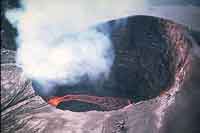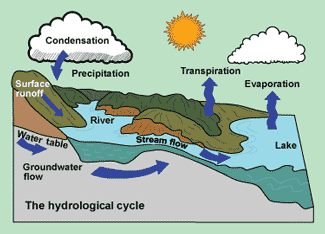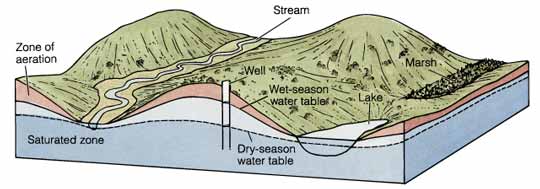THE NATURAL ENVIRONMENT
Geography 101
ToC
WATER
Cycle
Balance
Water In
Water Out
Soil
Classify
Earth's Water
Origin
|
|
BOX 1 |
Earth's surface water accumulated over
billions of years by precipitation of water vapor that entered the atmosphere
through outgassing from volcanoes, fumaroles, and other vents.  This
water filled the ocean basins and saturated the land. Streams
picked up dissolved salts on land surfaces and carried them down to
the oceans, gradually increasing the salinity to today's concentration.
To a lesser extent, undersea hydrothermal vents and volcanism also produce oceanic salts. Oceanographers believe that the oceanic salinity
and quantity of
surface water in all forms has stabilized over geologic time as the amount
of new water added by outgassing and new salt gained by runoff is offset
by water lost through tectonism and salt lost through the formation of
salt deposits from ancient seas.
This
water filled the ocean basins and saturated the land. Streams
picked up dissolved salts on land surfaces and carried them down to
the oceans, gradually increasing the salinity to today's concentration.
To a lesser extent, undersea hydrothermal vents and volcanism also produce oceanic salts. Oceanographers believe that the oceanic salinity
and quantity of
surface water in all forms has stabilized over geologic time as the amount
of new water added by outgassing and new salt gained by runoff is offset
by water lost through tectonism and salt lost through the formation of
salt deposits from ancient seas.
Reservoirs of Water
Water source |
Water volume,
in cubic kilometers |
Percent of total
water |
|
| Oceans | 1,338,000,000 |
96.50% |
|
| Ice and snow | 24,364,000 |
1.76% |
Ground water | 23,400,000 |
1.69% |
| Lakes and swamps | 102,470 |
0.008% |
|
| Inland seas (saline) | 85,400 |
0.006% |
|
| Soil moisture | 16,500 |
0.001% |
|
| Atmosphere | 12,900 |
0.001% |
|
| Rivers | 2,120 |
0.0002% |
|
| Total water volume | 1,385,983,390 |
||
Source: US Geologic
Survey (2015) |
|||
 The
oceans are by far the largest reservoir, containing 96.5% of all
surface water. They provide a stable habitat for Earth's marine life,
including the world's most ancient creatures. Salinity averages about
35 parts
per
thousand.
The
oceans are by far the largest reservoir, containing 96.5% of all
surface water. They provide a stable habitat for Earth's marine life,
including the world's most ancient creatures. Salinity averages about
35 parts
per
thousand.
 Of
the remaining 3.5%, about half is stored as fresh water ice,
particularly in the huge ice caps of Antarctica and Greenland, which
are over three kilometers (two
miles) thick at their centers. Groundwater is the next
largest reservoir, containing about 1.69%. Groundwater is the largest water source
for human use, although about half is saline. Salt water lakes, also called inland seas, hold about 0.006%.
Of
the remaining 3.5%, about half is stored as fresh water ice,
particularly in the huge ice caps of Antarctica and Greenland, which
are over three kilometers (two
miles) thick at their centers. Groundwater is the next
largest reservoir, containing about 1.69%. Groundwater is the largest water source
for human use, although about half is saline. Salt water lakes, also called inland seas, hold about 0.006%.
 Only
about
0.01%
of Earth's
surface water
takes the familiar forms we depend on as fresh water lakes, swamps, rivers,
soil water, and water in the atmosphere.
These contain only tiny fractions of Earth's total water, but
are disproportionately important
for many reasons ranging from supporting life to wearing
away mountains by erosion.
Only
about
0.01%
of Earth's
surface water
takes the familiar forms we depend on as fresh water lakes, swamps, rivers,
soil water, and water in the atmosphere.
These contain only tiny fractions of Earth's total water, but
are disproportionately important
for many reasons ranging from supporting life to wearing
away mountains by erosion.
Hydrologic Cycle
 Water
continually cycles between these reservoirs, both through the atmosphere
and over land. Scientists call this process the hydrologic cycle, illustrated
in the diagram. Earlier we discussed the atmospheric component on this cycle: evaporation, condensation and precipitation
(see Chapter
5 -> Evap).
Overall, there is a net transfer of water from ocean surfaces to land through
the atmospheric component of the hydrologic cycle.
Water
continually cycles between these reservoirs, both through the atmosphere
and over land. Scientists call this process the hydrologic cycle, illustrated
in the diagram. Earlier we discussed the atmospheric component on this cycle: evaporation, condensation and precipitation
(see Chapter
5 -> Evap).
Overall, there is a net transfer of water from ocean surfaces to land through
the atmospheric component of the hydrologic cycle.
In this chapter, we focus on what happens to water reaching land surfaces. As shown in the diagram, some precipitation falling on land accumulates and flows downhill as surface runoff. Surface runoff collects in tiny rills of water washing down mountain slopes. Rills eventually drain into larger streams, which in turn merge into even larger rivers, which empty into lakes, inland seas, and the ocean.
Some precipitation also soaks into the surface, a process called infiltration. Some of the infiltrated water percolates downward through the zone of aeration into the saturated zone, where groundwater occupies the gaps between soil particles and cracks in bedrock as shown below. The top of the saturated zone forms the water table. If you look down a well at the water surface, you are looking at the water table.

Lake and stream surfaces are also exposed areas of the water table. Surface runoff and groundwater both supply water for streams and rivers. This explains how perennial (year-round) streams can continue to flow during dry periods when no runoff occurs.
As shown in the diagram, the water table may fluctuate depending on the amount of groundwater added, perhaps through seasonal rainfall, and withdrawn, perhaps by stream flow. Changes in the water table can also be caused by human actions, such as well pumping, which we explore later in this chapter.